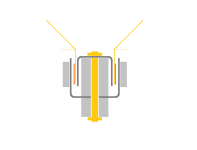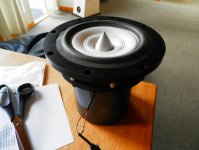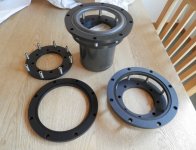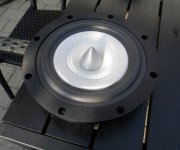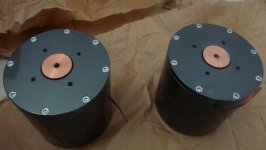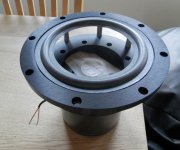regarding cone
a friend of mine have a nice pair of old Cerwin Vega S2
you may not believe it, but its got one hell of a fantastic midrange
and the cone is just one piece of paper sheet, cut, folded, and glued
this tells me that its a perfectly adequate method, and simple enough for DIY
DIY cone tweeter ?
a friend of mine have a nice pair of old Cerwin Vega S2
you may not believe it, but its got one hell of a fantastic midrange
and the cone is just one piece of paper sheet, cut, folded, and glued
this tells me that its a perfectly adequate method, and simple enough for DIY
DIY cone tweeter ?
I have been wanting to do this for years myself.
I was just looking at some nice styrofoam the other day that I could use for a cone/diaphragm of some type.
I was thinking about building a rectangular version for a small woofer or sub.
But the biggest thing that I have an issue with is what material would you use that is readily available for the surround?
I have seen many discussions on this subject through the years in these threads, But I never saw a decent solution yet.
I had an article once (late 70's) where someone had rebuilt woofer (an AR I think) using the green type of styrofoam used for Flower arrangements as it is very very lite!!
That worked very well but he also used a round replacement surround for it and I want to build a square or rectangular version.
jer
I was just looking at some nice styrofoam the other day that I could use for a cone/diaphragm of some type.
I was thinking about building a rectangular version for a small woofer or sub.
But the biggest thing that I have an issue with is what material would you use that is readily available for the surround?
I have seen many discussions on this subject through the years in these threads, But I never saw a decent solution yet.
I had an article once (late 70's) where someone had rebuilt woofer (an AR I think) using the green type of styrofoam used for Flower arrangements as it is very very lite!!
That worked very well but he also used a round replacement surround for it and I want to build a square or rectangular version.
jer
Last edited:
I repaired and used those weird Yamaha speakers in the 70's, and as I remember, there was not a separate surround but the cone was molded with precision (it was also a very fine grain and smooth surface Styrofoam, not your typical portable frigobox type) , the edge was thin, curved and flexible.
If you tapped the cone, it thumped with a deep note, like the large speaker it was.
And sound was killer, compared to an average speaker of that era (think "Fender" Oxford/CTS/etc.)
Beyond what a DIY Hobbyst can do, it requires an expensive special die.
If you tapped the cone, it thumped with a deep note, like the large speaker it was.
And sound was killer, compared to an average speaker of that era (think "Fender" Oxford/CTS/etc.)
Beyond what a DIY Hobbyst can do, it requires an expensive special die.
Hello
I started for almost a year ago on a full range project and I got hooked.... you relay can make a super full range unit, but it has a high cost when you want to make the best of the best. I am using some clouded cellular foam as cone it is very light weight, a 6” cone weighed 1.5 gram. Also I am using a field coil as a magnet and a custom made speaker basket. I think I will have them finished primo 2014.
Here is some pictures.
Take care.
I started for almost a year ago on a full range project and I got hooked.... you relay can make a super full range unit, but it has a high cost when you want to make the best of the best. I am using some clouded cellular foam as cone it is very light weight, a 6” cone weighed 1.5 gram. Also I am using a field coil as a magnet and a custom made speaker basket. I think I will have them finished primo 2014.
Here is some pictures.
Take care.
Attachments
If you're giving a demonstration, rather than turning some guys loose to build their own speakers, you might think about an electrostatic speaker. It's comparatively easy to build a speaker with good fidelity from the ground up.
You can drive it from a low voltage amp if you use a centre-tapped audio transformer, but you'll need a bias supply, probably >500V, but only low current is required, so it's not too dangerous. Not that difficult to arrange either...
Take a look at Rod Elliott's site for some inspiration:- Project 105 - Build an ESL
You can get lo-fi sound out of a flat flexible steel sheet excited by what is effectively an electromagnet with a ground pole-piece spaced close to the sheet. Old-style high-impedance headphones used to be built this way. Again a bias voltage is helpful, otherwise you get all the frequencies multiplied *2.
You can drive it from a low voltage amp if you use a centre-tapped audio transformer, but you'll need a bias supply, probably >500V, but only low current is required, so it's not too dangerous. Not that difficult to arrange either...
Take a look at Rod Elliott's site for some inspiration:- Project 105 - Build an ESL
You can get lo-fi sound out of a flat flexible steel sheet excited by what is effectively an electromagnet with a ground pole-piece spaced close to the sheet. Old-style high-impedance headphones used to be built this way. Again a bias voltage is helpful, otherwise you get all the frequencies multiplied *2.
There are many very very good threads about Building ESL's in this forum if one chooses to build one, and, it evolves voltages much much higher than 500V.
Typically it takes at least 2Kv to 3kv of bias voltage to make a panel work successfully.
Low currents are involved but they can reach very high values as well.
And so you MUST practice and RESPECT the rules and cautions that go along with working with such high voltages.
But when done right it is a very rewarding process and hobby.
I am very active in that field of speaker technology and I have dealt with voltages as high as 10KV to 25KV across my panel designs before.
Typically under normal listening conditions the voltages will be no more than about 6Kv Peak across the stator's.
Depending on how hard you push them, and, How loud you listen to them.
Another type of speaker design that can be very rewarding would be of the magnetic planar and ribbon types, Check some of JamesBos's threads and his design's as those are very inspiring builds as well.
Such designs as those are probably easiest to build using magnets and you will still be able to yield some very excellent results with a very low THD factor.
I have seen some builds made as small as what would fit inside an Altoids tin and used for desktop computer speakers that had great results!!!
When it comes to cone size decisions, The overall displacement of the Cone or Diaphragm will determine how loud it can be.
Here is a calculator that will help you to get some kind of idea as to how big you should build your speaker,
Piston Excursion calculator
This is the home page to where the calculator is located,
Bass may be BAD but it sure feels GOOD!
and some chart's can be found here as well,
http://www.diyaudio.com/forums/multi-way/5668-volume-displacement-spl-chart.html#post55867
Also here is a Spreadsheet from Linkwitz lab's that I use a lot too,
https://www.google.com/url?sa=t&rct...0IHoAw&usg=AFQjCNH1QR1HeW1veDd2cgjFxR9EneC8Kg
It calculates both Monpole and Dipole configurations for SPL vs Displacement as per frequency.
FWIW
jer
P.S. Great looking build there, Frank40 !!!
Typically it takes at least 2Kv to 3kv of bias voltage to make a panel work successfully.
Low currents are involved but they can reach very high values as well.
And so you MUST practice and RESPECT the rules and cautions that go along with working with such high voltages.
But when done right it is a very rewarding process and hobby.
I am very active in that field of speaker technology and I have dealt with voltages as high as 10KV to 25KV across my panel designs before.
Typically under normal listening conditions the voltages will be no more than about 6Kv Peak across the stator's.
Depending on how hard you push them, and, How loud you listen to them.
Another type of speaker design that can be very rewarding would be of the magnetic planar and ribbon types, Check some of JamesBos's threads and his design's as those are very inspiring builds as well.
Such designs as those are probably easiest to build using magnets and you will still be able to yield some very excellent results with a very low THD factor.
I have seen some builds made as small as what would fit inside an Altoids tin and used for desktop computer speakers that had great results!!!
When it comes to cone size decisions, The overall displacement of the Cone or Diaphragm will determine how loud it can be.
Here is a calculator that will help you to get some kind of idea as to how big you should build your speaker,
Piston Excursion calculator
This is the home page to where the calculator is located,
Bass may be BAD but it sure feels GOOD!
and some chart's can be found here as well,
http://www.diyaudio.com/forums/multi-way/5668-volume-displacement-spl-chart.html#post55867
Also here is a Spreadsheet from Linkwitz lab's that I use a lot too,
https://www.google.com/url?sa=t&rct...0IHoAw&usg=AFQjCNH1QR1HeW1veDd2cgjFxR9EneC8Kg
It calculates both Monpole and Dipole configurations for SPL vs Displacement as per frequency.
FWIW
jer
P.S. Great looking build there, Frank40 !!!
Last edited:
I make my own speakers for my Guitar Amps, and it really involves a lot of heavy machinery (literally, measured in Tons), but as a schoolroom demonstration project, the improvised paper/magnet/wire/glue one is as fine as they come.
The idea is to show kids that the "boring theory" they have to learn in reality is very much alive, interesting, and behind things they love and use everyday.
The idea is to show kids that the "boring theory" they have to learn in reality is very much alive, interesting, and behind things they love and use everyday.
Thought I'd post an update. The presentation is over. It went OKAY. I'm extremely introverted. My potential diminishes around large crowds, which is quite unfortunate.
I wound 60 turns of 32awg around a small alnico magnet. I had a resistance of like .7? I can't remember. I stole kipkay's idea & used a paper plate. I mounted the whole thing on a tupperware bowl & used folded business cards for the suspension.
Anyways, the quarter watt from the LM386 didn't quite cut it. Some of the students from the back walked up to the front to take a closer listen (which was great).
Electromagnet & permanent magnet was easy. Getting the signal however, was a disaster. I'm never explaining the hand rules backwards again, lmao. -Remember, I'm facing the crowd
Please check out the LM386 thread in the amplifier section.
Thanks!
I wound 60 turns of 32awg around a small alnico magnet. I had a resistance of like .7? I can't remember. I stole kipkay's idea & used a paper plate. I mounted the whole thing on a tupperware bowl & used folded business cards for the suspension.
Anyways, the quarter watt from the LM386 didn't quite cut it. Some of the students from the back walked up to the front to take a closer listen (which was great).
Electromagnet & permanent magnet was easy. Getting the signal however, was a disaster. I'm never explaining the hand rules backwards again, lmao. -Remember, I'm facing the crowd
Please check out the LM386 thread in the amplifier section.
Thanks!
Hello
I started for almost a year ago on a full range project and I got hooked.... you relay can make a super full range unit, but it has a high cost when you want to make the best of the best. I am using some clouded cellular foam as cone it is very light weight, a 6” cone weighed 1.5 gram. Also I am using a field coil as a magnet and a custom made speaker basket. I think I will have them finished primo 2014.
Here is some pictures.
Take care.
Might sound silly but do you have a recording? I know the ryu had some. Also finished is a funny word when your trying to make the best.
Last edited:
Might sound silly but do you have a recording? I know the ryu had some. Also finished is a funny word when your trying to make the best.
Hi, No I do not have any recordings of the unit, it wouldn’t bee fair to make a video with sound course it wouldn't show how they sound. (not with my camera anyway).
You nailed it quit well “finished “ is a funny word. I have been throw so many changes, but at some point you have to decide... and I think it it now. So I have order some CNC aluminium’s formers to hot press the Depron sheets, this will insure a uniform production (2psc for now). But If I come across new knowledges the units might bee modified.
Take care
Congratulations.
And next time use a good old TDA2003, they are *designed* for 2 ohm loads, which is much more than the LM386 can handle.
And 100 turns of 0.20mm wire, wound 2 layers (back and forth) on a 2" paper/mylar tube, will give you around 6 ohms DC resistance for an 8 ohms nominal voice coil.
That's exactly what I use on one of my homemade commercial Guitar speakers.
This, even without a proper iron magnetic circuit but with a powerful Neo magnet, will let *all* pupils hear loud and clear.
And next time use a good old TDA2003, they are *designed* for 2 ohm loads, which is much more than the LM386 can handle.
And 100 turns of 0.20mm wire, wound 2 layers (back and forth) on a 2" paper/mylar tube, will give you around 6 ohms DC resistance for an 8 ohms nominal voice coil.
That's exactly what I use on one of my homemade commercial Guitar speakers.
This, even without a proper iron magnetic circuit but with a powerful Neo magnet, will let *all* pupils hear loud and clear.
- Status
- This old topic is closed. If you want to reopen this topic, contact a moderator using the "Report Post" button.
- Home
- Design & Build
- Construction Tips
- How to design a loudspeaker
